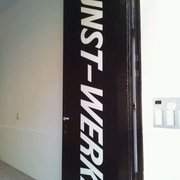KW Institute for Contemporary Art
Edit
-
Auguststr. 69
10117 Berlin
Germany Mitte - Get Directions
-
Ad
Media Markt
0.9 Miles away from KW Institute for Contemporary ArtTorterry C. said "This is my favorite Media Markt in Berlin. Compare with others, I really prefer to come this one more, even it isn't so…" read more
Recommended Reviews
Page 1 of 1















 ,
,  and related marks are registered trademarks of Yelp.
and related marks are registered trademarks of Yelp.